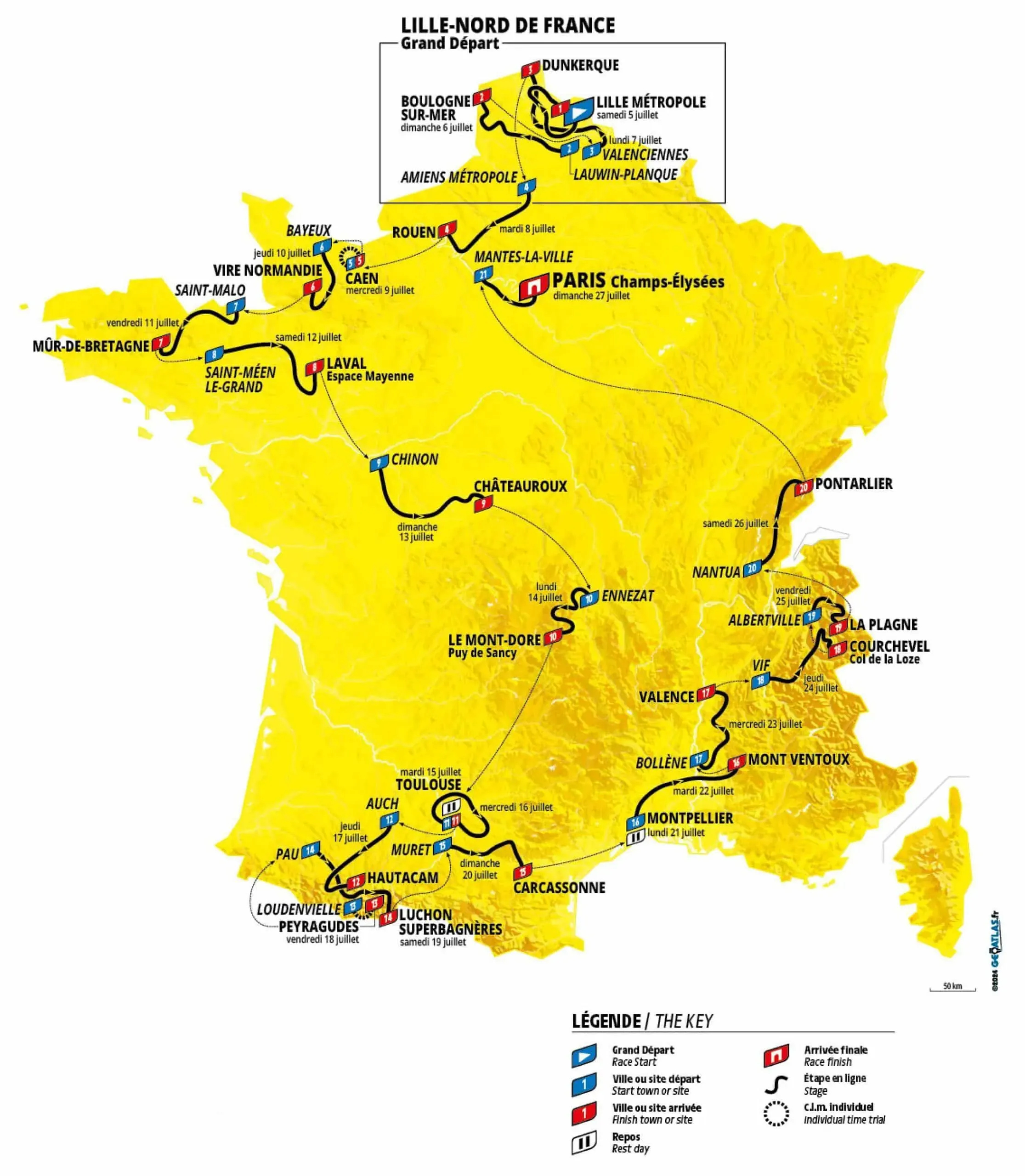The excitement surrounding the Tour de France 2025 is palpable as fans witness yet another exhilarating chapter in the epic cycling event. On Sunday, July 13, Tim Merlier capped off a thrilling sprint finish in Châteauroux, marking his second impressive victory during this year’s race. His success came against the backdrop of Mathieu van der Poel’s valiant effort, which faltered just 700 meters from the finish line, expertly cutting his performance short. Cycling enthusiasts are buzzing about the spirited displays from the Alpecin team as they showcased remarkable determination despite the challenges, including Van der Poel’s breakdown during the critical moments of the race. With standout performances and intense competition, the Tour de France continues to be a showcase of elite cycling prowess, creating unforgettable memories for participants and fans alike.
As we dive into the thrilling world of the 2025 edition of the Grand Tour, the anticipation and drama unfold across the picturesque landscapes of France. The thrilling sprint finishes have become a hallmark of this prestigious cycling race, with competitors like Tim Merlier and Mathieu van der Poel stealing the spotlight with their fierce rivalries and brave exploits. Spectators in Châteauroux witnessed a spectacular showdown that highlighted not only individual talent but also team dynamics, particularly from renowned squads like Alpecin. The recent events emphasize the blend of strategy and athleticism inherent in professional cycling, drawing attention to memorable performances and unexpected outcomes. This year’s Tour de France promises to be a riveting saga that will be remembered long after the champions are crowned.
Merlier’s Stunning Sprint Victory in Châteauroux
Tim Merlier’s outstanding performance in Châteauroux marked his second consecutive sprint victory during the Tour de France 2025. The stage showcased not only Merlier’s talent but also his strategic prowess as he strategically maneuvered through the peloton, demonstrating the skills that have made him a formidable sprinter in the cycling world. With competition intensifying, Merlier’s ability to thrive under pressure was evident as he expertly navigated the challenging sprint finish, ultimately outsmarting his competitors.
His victory highlights a significant trend in this year’s Tour de France, where sprint stages have been defining moments for many cyclists. Riders are not just racing for points but are battling for glory in a showcase of speed and endurance. Merlier’s win is a testament to his resilience and preparation, embodying the relentless spirit of the Tour that cycling fans have come to love.
The Thrills and Spills: Van der Poel’s Grind
Mathieu van der Poel’s attempt to secure a winning position in Châteauroux came to a dramatic halt when he was eventually caught by the peloton. His early breakaway alongside teammate Jonas Rickaert captivated fans and showcased the tenacity of Alpecin’s performance during this Tour de France. Although he missed out on the stage victory, Van der Poel’s combativeness and commitment to the race earned him respect and admiration from his peers and fans alike.
The circumstances surrounding Van der Poel’s breakdown just 700 meters from the finish exemplified the harsh realities of competitive cycling. After leading for much of the stage, the exertion took its toll, and he was unable to fend off the approaching pack. Despite falling short, his determined effort added excitement to the stage’s narrative, demonstrating the unpredictable nature of the Tour. Such moments are part of what makes the sport captivating, reminding viewers of the delicate balance between ambition and physical limits.
Alpecin’s Impact in Tour de France 2025
The Alpecin team’s strategy in this Tour de France is worthy of examination, especially considering the pivotal roles played by riders like Van der Poel and Rickaert. Their decision to attack early on during the stage to Châteauroux was a clear indication of their aggressive playstyle, aimed at not only competing for stage wins but also adding excitement to the race. This approach, though risky, demonstrates the team’s commitment to seizing opportunities as they arise, engaging with the peloton instead of merely following.
Moreover, the combativity displayed by Alpecin’s riders reinforces the team’s capability and ambition in this year’s competition. While Rickaert faced exhaustion and ultimately conceded defeat in his breakaway, his earlier initiatives set the stage for Van der Poel to make an impactful bid for victory, thus enhancing the team’s overall performance and presence in the Tour. Alpecin’s spirited efforts suggest a broader trend in cycling where teams are increasingly willing to take calculated risks to energize the race and please fans.
Sprint Finish Trends in Cycling
The rapid pace of the peloton in the sprint finish of stages like that in Châteauroux captures the essence of competitive cycling—a blend of speed, strategy, and stamina. With an impressive average speed of 50.013 km/h, the race pushed cyclists to their limits, igniting fierce competition among sprinters. These high-speed finishes are often the most exhilarating moments of the Tour de France, drawing significant fan engagement as riders jockey for position in the final kilometers.
As we look ahead to the upcoming stages, the importance of sprint finishes cannot be understated. They serve not only as crucial opportunities for points in the green jersey competition but also as highlights of the Tour that showcase individual talent and team strategy. The anticipation of who will emerge victorious in each sprint finish is a driving factor for teams and spectators alike, making each stage a vital component of the overall race narrative.
Preparing for the Mountain Challenges Ahead
As the Tour de France progresses, the focus now shifts to the mountain stages that lie ahead. Sprinters like Tim Merlier, who have thrived in the flat and fast sections, are now faced with the daunting reality of tackling steep climbs and demanding terrains. The transition from sprinting on the flat to climbing in the mountains presents a pivotal challenge, and it requires not only physical strength but also strategic acclimatization by the teams.
With Tadej Počagar maintaining his yellow jersey amid deteriorating team conditions following Joao Almeida’s abandonment, the dynamics of the race will rapidly evolve. The support left for Počagar will be imperative as the Tour enters its climactic phases. How well teams adapt to this pivotal change and manage their riders will be crucial to their success in overcoming these final hurdles and competing for overall victory.
The Role of Team Dynamics in Success
In competitive cycling, the significance of team dynamics cannot be overstated, especially in a high-stakes event like the Tour de France. Teams such as Alpecin emphasize the importance of cohesion and support among their riders, as seen in their joint efforts during the Châteauroux stage. The ability to work together effectively enables teams not only to target victories but also to ensure that their top contenders are well-supported throughout the grueling race.
As the competition becomes fiercer, maintaining strong inter-team relationships will be essential for success. Each cyclist plays a crucial role in the strategy, whether launching breakaways, providing drafting support, or pacing their leaders through difficult sections. This shared experience builds resilience and increases the likelihood of achieving individual and team goals in the demanding stages of the Tour.
The Legacy of the Tour de France: A Continual Evolution
The Tour de France is not merely a race; it embodies a rich cycling tradition that has evolved over the years. Each edition, including Tour de France 2025, showcases unique stories of individual determination and team strategy, as well as shifts in competitive landscapes driven by emerging talent and tactical innovations. The excitement surrounding each stage reflects cycling’s adaptability and the global sporting community’s engagement.
As we witness new narratives unfold this year, from Merlier’s thrilling victories to Počagar’s battle for yellow, the legacy of the Tour continues to grow. The fluctuations in strategy, the rise and fall of competitors, and the unpredictable nature of racing contribute to its enduring appeal. Fans are eager to see how the remaining stages will define the season, influencing both current and future generations of cyclists.
Fan Engagement and the Future of Cycling Events
The Tour de France draws millions of fans from around the world, creating an electric atmosphere that elevates the event beyond a mere race. Engaging with fans through social media platforms, live broadcasts, and interactive coverage allows for a deeper connection to the cycling community. Events like the Tour de France 2025 exemplify the fusion of traditional sporting excellence with modern media outreach, which plays a critical role in the event’s global popularity.
As the Tour continues to innovate in how it interacts with audiences, capturing the spirit of the race through behind-the-scenes content and rider stories is vital. Fans today crave more than just results; they seek a personal connection to the athletes and a fuller understanding of their journeys. In this context, the evolution of fan engagement strategies will be essential for maintaining the Tour’s relevance and popularity in the years to come.
Understanding Cycling Strategy: Lessons from the Race
The tales of strategy and tactics unfold prominently in the Tour de France. Each stage requires teams to analyze competing riders, understand the course, and adapt on the fly—all skills showcased during the sprint finish in Châteauroux. By strategically selecting which rider makes a move and when, teams can maximize their chances for success, illustrating the profound impact of intent and preparation on racing outcomes.
As encountered in Châteauroux, the balance between personal ambition and team success often defines the race. Understanding the intricacies of cycling strategy not only deepens appreciation for the sport but also signals growth opportunities for aspiring cyclists and teams. The insights gained from this year’s Tour are invaluable for future races, shaping how competitors approach the balance of teamwork and individual aspiration.
Frequently Asked Questions
What was Tim Merlier’s achievement in the Tour de France 2025?
In the Tour de France 2025, Tim Merlier celebrated his second sprint victory in Châteauroux, further solidifying his status as a top sprinter in this prestigious cycling event.
How did Mathieu van der Poel perform in the Tour de France 2025?
Mathieu van der Poel provided an exciting performance during the Tour de France 2025, participating in a daring breakaway before ultimately being caught by the peloton just 700 meters from the finish line.
What role did Châteauroux play in the Tour de France 2025 race?
Châteauroux served as a crucial stage in the Tour de France 2025, where Tim Merlier secured a thrilling victory in a fast-paced sprint finish, marking it as a memorable day in the cycling event.
What challenges did the riders face in the Tour de France 2025 sprints?
Riders faced significant challenges during the Tour de France 2025 sprints, including extreme heat and the need to navigate through a fast-paced peloton, particularly evident during Merlier’s victory.
How did the Alpecin team perform in the Tour de France 2025?
The Alpecin team showcased strong performance in the Tour de France 2025, with Mathieu van der Poel and Jonas Rickaert engaging in an ambitious breakaway that captivated fans before Van der Poel was caught.
What implications did Joao Almeida’s abandonment have for the Tour de France 2025?
Joao Almeida’s abandonment due to a fall significantly impacted his team, as Tadej Pogacar lost a key ally for the challenging mountain stages that await in the Tour de France 2025.
What was the significance of the sprint finish in the Tour de France 2025?
The sprint finish in the Tour de France 2025 was significant not only for Tim Merlier’s victory but also because it featured the second-fastest stage in history, with an impressive average speed of 50.013 km/h.
How did the weather affect the riders in the Tour de France 2025?
The weather during the Tour de France 2025 posed challenges for riders, particularly the heat, which affected hydration and performance, as noted by Tim Merlier after his victory.
What was the Combativity Award and who received it during the Tour de France 2025?
The Combativity Award, granted for notable efforts during the race, was awarded to Jonas Rickaert in the Tour de France 2025 for his daring breakaway attempt alongside Mathieu van der Poel.
| Key Point | Details |
|---|---|
| Tim Merlier’s Victory | Tim Merlier won his second sprint in the Tour de France 2025 in Châteauroux. |
| Breakaway Effort | Mathieu van der Poel and Jonas Rickaert attempted a daring breakaway to win the stage, showcasing remarkable teamwork. |
| Peloton Performance | The peloton finished the stage at an impressive speed of 50.013 km/h, making it the second-fastest stage in Tour de France history. |
| Challenges Faced | Heat and hydration issues posed significant challenges for the cyclists, particularly Merlier during the final moments of the race. |
| Pogacar’s Situation | Although Tadej Pogacar maintains his yellow jersey, he suffers a setback with the abandonment of Joao Almeida after a fall. |
Summary
Tour de France 2025 has been an exciting spectacle, with Tim Merlier achieving another remarkable sprint victory and showcasing the resilience and determination of cyclists throughout the competition. The dramatic moments, including the daring breakaway by van der Poel and Rickaert, have captivated fans and added to the rich narrative of this prestigious event. As the sprinters now prepare for the challenging mountain stages ahead, the stakes are high, and every performance will be critical in shaping the outcome of this year’s Tour.



